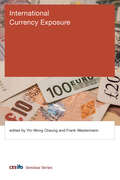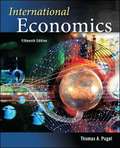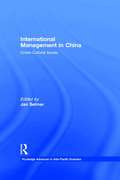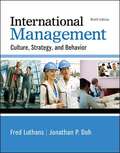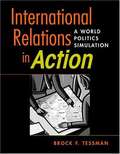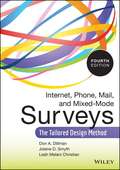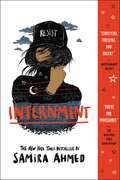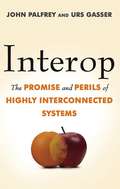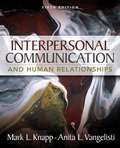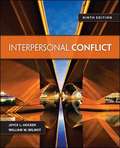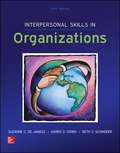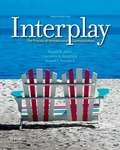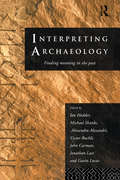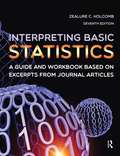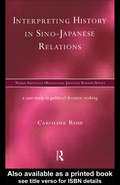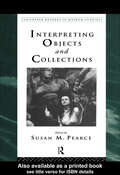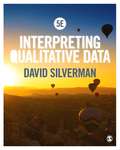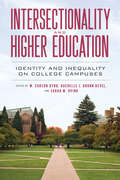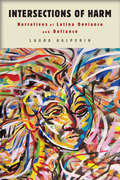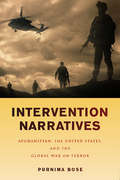- Table View
- List View
International Business Strategy
by Alain VerbekeHow can you best extend your knowledge of how multinational enterprises (MNEs) function? What does globalization mean for today's managers? How do students turn the message from academic literature into effective business strategies within an MNE? This practical textbook shows how the key concepts from business strategy literature can be applied to multinational enterprise. MBA and Masters students will gain the practical knowledge and skills needed to succeed as effective managers in multinational companies through a critical study of mainstream strategy models and the analysis of forty-five key journal articles. More than twenty 'half-length' case studies from leading firms including Honda, IKEA and Danone show globalization in practice at the firm level. The book also Identifies seven central themes from the literature for successful global strategies and unifies them into a clear framework that can be applied to real businesses worldwide.
International Criminal Law and Philosophy
by Larry May Zachary HoskinsInternational Criminal Law and Philosophy is the first anthology to bring together legal and philosophical theorists to examine the normative and conceptual foundations of international criminal law. In particular, through these essays the international group of authors addresses questions of state sovereignty; of groups, rather than individuals, as perpetrators and victims of international crimes; of international criminal law and the promotion of human rights and social justice; and of what comes after international criminal prosecutions, namely, punishment and reconciliation. International criminal law is still an emerging field, and as it continues to develop, the elucidation of clear, consistent theoretical groundings for its practices will be crucial. The questions raised and issues addressed by the essays in this volume will aid in this important endeavor.
International Currency Exposure (CESifo Seminar Series)
by Yin-Wong Cheung Frank WestermannIssues in debates about foreign currency exposure—the denomination of liabilities or assets in foreign currency. The foreign currency denomination of contracts in international transactions can lead to international currency exposure at the country level with important economic and policy implications. When debts are denominated in foreign currency and revenues in domestic currency, exchange rate fluctuations can result in balance sheet effects for countries with either net asset or liability positions. Moreover, currency mismatch between assets and liabilities can be a cause for crises in developing and emerging economies. This book looks at the issues surrounding foreign currency exposure in today's increasingly integrated world economy.The contributors draw on cross-country as well as country-specific data. They consider international currency risk after the Swiss franc ended its one-sided peg with the euro, for example, and the foreign exchange positions of firms in Turkey and Russia. Other contributors take macroeconomic perspectives, examining the potential effects of exchange rate realignment, the pressure to appreciate on countries with current account surpluses, and the currency exposure in international trade. Finally, contributors consider the issue from finance and political economy perspectives, addressing the phenomenon of the forward premium puzzle and discussing geopolitical aspects ascending currencies. Contributors Fatih Altunok, Huseyin Aytug, Agustín S. Bénétrix, Jörg Breitung, Paul De Grauwe, Eiji Fujii, Peter Garber, Juann H. Hung, Signe Krogstrup, Philip R. Lane, Katja Mann, Arif Oduncu, Gunther Schnabl, Maria V. Sokolova, Cédric Tille
International Economics (Fifteenth Edition)
by Thomas PugelInternational Economics, 15e continues to combine rigorous economic analysis with attention to the issues of economic policy that are alive and important today in this field. Written in a concise and readable format, Pugel uses economic terminology when enhancing the analysis so that the reader can build their understanding of global economic developments and evaluate proposals for changes in economic policies. The text is informed by current events and includes the latest in applied international research, all the time avoiding jargon for jargon's sake. Like earlier editions, Pugel also places international economics events within a historical framework. The overall treatment continues to be intuitive rather than mathematical and is strongly oriented towards policy.
International Finance: Theory and Policy
by Steve SuranovicInternational Finance Theory and Policy is built on Steve Suranovic's belief that to understand the international economy, students need to learn how economic models are applied to real world problems. It is true what they say, that "economists do it with models." That's because economic models provide insights about the world that are simply not obtainable solely by discussion of the issues. International Finance Theory and Policy develops a unified model of the international macroeconomy. The text provides detailed descriptions of major macroeconomic variables, covers the interest rate parity and purchasing power parity theories of exchange rate determination, takes an exhaustive look at the pros and cons of trade imbalances and presents the well-known AA-DD model to explore the effects of fiscal and monetary policy under both fixed and flexible exchange rates. The models are developed, not by employing advanced mathematics, but rather by walking students through a detailed description of how a model's assumptions influence its conclusions. But more importantly, each model and theory is connected to real world policy issues. The Finance Text has the following unique features: o Begins with an historical overview of the international macroeconomy to provide context for the theory. o Concludes with a detailed discussion of the pros and cons of fixed and floating exchange rate systems. o Provides an extensive look at the issue of trade imbalances. Readers learn techniques to evaluate whether a country's trade deficit (or surplus) is dangerous, beneficial, or benign. o Explains how purchasing power parity is used to make cross country income comparisons. o Offers clear detailed explanations of the AA-DD model. o Applies the AA-DD model to understand the effects of monetary and fiscal policy on GDP, the exchange rate, and the trade balance.
International Financial Management
by Jeff MaduraPrepare for success in international finance with this best-selling book's effective presentation of in-depth theory and practical applications. INTERNATIONAL FINANCIAL MANAGEMENT 12E builds on the fundamental principles of corporate finance to provide the timely information and contemporary insights needed to prosper in today's global business environment. This book discusses a wide range of managerial topics using a strong corporate perspective and highlights financial reform and its impact on the international finance today. An emphasis on the most recent financial industry trends further prepares readers to understand and effectively manage within the dynamic field of international finance.
International Management in China: Cross-Cultural Issues (Routledge Advances in Asia-Pacific Business #Vol. 7)
by Jan SelmerThe greatest challenge to international business today is how to manage business operations across cultural boundaries. This is especially true in the case of China, which has attracted a massive amount of foreign investment and international trade recently. This new study examines three main themes:* the partnership of management through joint ventures* the human resource aspects of management* the management of communication, co-operation and negotiationThe crucial issue of trustworthiness, the different managerial practices in China and the West, the importance of being well prepared and understanding Chinese negotiations are the major contemporary issues identified and discussed in this book.
International Management: Culture, Strategy, and Behavior (Ninth Edition)
by Fred Luthans Jonathan P. DohInternational Management: Culture, Strategy, and Behavior reflects new and emerging developments influencing international managers. With integrated real-world examples, research, and practical applications, students understand how to adjust, adapt, and navigate the changing global business landscape and respond to global challenges - making it a market - leader. The authors retain research and practices over the past decades, and incorporate new and emerging developments affecting international managers to increase students' effectiveness in managing across cultures.
International Relations in Action: A World Politics Simulation
by Brock TessmanThis hands-on exercise allows students to relate the concepts and issues at the foundation of global politics to the realities of international politics today. As influential leaders in the fictional world of Politica, each team of students governs a country with a unique history, geography, and culture. The teams must use strategy and negotiation to succeed - and survive - seeking to achieve specific territorial, security, and economic objectives. In the process, they grapple with a range of complex challenges: energy security, ethnic conflict, humanitarian intervention, environmental disaster, terrorism, nuclear proliferation, and more. Students also pursue individual objectives based on the governmental post they hold - and quickly learn that self-interest and national interest are not always compatible. Teams are judged on their effectiveness in meeting stated objectives, but must also relate their practical experience to the academic content of the course. Toward this end, the book provides summaries, analysis, study questions, and additional sources of information for each of the theories and issues encountered during the simulation. Guidelines for instructors are also included. "International Relations in Action" has been tested in multiple courses, with students and instructors unanimously agreeing that it makes abstract theories practical and accessible, evokes an appreciation for the complexity of international politics, and generates enthusiasm for the study of international relations. In the representative words of one student, "It was the best learning experience I've ever had."
International Research in Sports Biomechanics
by Youlian HongThis edited collection of papers presented at the 18th International Symposium of Biomechanics in Sport, highlights cutting-edge research material on sports biomechanics from many of the leading international academics in the field. The thirty-seven chapters presented are divided into nine sections: * biomechanics of fundamental human movement* modelling, simulation and optimisation* biomechanics of the neuro-musculo-skeletal system* sports injuries, orthopaedics and rehabilitation* the application of electromyography in movement studies* biomechanical analysis of the internal load* methods and instrumentation* training* paediatric and geriatric exercise.
Internet, Phone, Mail, and Mixed-Mode Surveys: The Tailored Design Method (Fourth Edition)
by Don A. Dillman Leah Melani Christian Jolene D. SmythThe classic survey design reference, updated for the digital age For over two decades, Dillman's classic text on survey design has aided both students and professionals in effectively planning and conducting mail, telephone, and, more recently, Internet surveys. The new edition is thoroughly updated and revised, and covers all aspects of survey research. It features expanded coverage of mobile phones, tablets, and the use of do-it-yourself surveys, and Dillman's unique Tailored Design Method is also thoroughly explained. This invaluable resource is crucial for any researcher seeking to increase response rates and obtain high-quality feedback from survey questions. Consistent with current emphasis on the visual and aural, the new edition is complemented by copious examples within the text and accompanying website. This heavily revised Fourth Edition includes: Strategies and tactics for determining the needs of a given survey, how to design it, and how to effectively administer it How and when to use mail, telephone, and Internet surveys to maximum advantage Proven techniques to increase response rates Guidance on how to obtain high-quality feedback from mail,electronic, and other self-administered surveys Direction on how to construct effective questionnaires,including considerations of layout The effects of sponsorship on the response rates of surveys Use of capabilities provided by newly mass-used media:interactivity, presentation of aural and visual stimuli. The Fourth Edition reintroduces the telephone-including coordinating land and mobile. Grounded in the best research, the book offers practical how-to guidelines and detailed examples for practitioners and students alike.
Internment
by Samira AhmedRebellions are built on hope. <P><P>Set in a horrifying near-future United States, seventeen-year-old Layla Amin and her parents are forced into an internment camp for Muslim American citizens. <P><P>With the help of newly made friends also trapped within the internment camp, her boyfriend on the outside, and an unexpected alliance, Layla begins a journey to fight for freedom, leading a revolution against the internment camp's Director and his guards. <P><P>Heart-racing and emotional, Internment challenges readers to fight complicit silence that exists in our society today. <P><b>A New York Times Bestseller</b>
Interop: The Promise and Perils of Highly Interconnected Systems
by John Palfrey Urs GasserIn Interop, technology experts John Palfrey and Urs Gasser explore the immense importance of interoperability-the standardization and integration of technology-and show how this simple principle will hold the key to our success in the coming decades and beyond. The practice of standardization has been facilitating innovation and economic growth for centuries. The standardization of the railroad gauge revolutionized the flow of commodities, the standardization of money revolutionized debt markets and simplified trade, and the standardization of credit networks has allowed for the purchase of goods using money deposited in a bank half a world away. These advancements did not eradicate the different systems they affected; instead, each system has been transformed so that it can interoperate with systems all over the world, while still preserving local diversity. As Palfrey and Gasser show, interoperability is a critical aspect of any successful system-and now it is more important than ever. Today we are confronted with challenges that affect us on a global scale: the financial crisis, the quest for sustainable energy, and the need to reform health care systems and improve global disaster response systems. The successful flow of information across systems is crucial if we are to solve these problems, but we must also learn to manage the vast degree of interconnection inherent in each system involved. Interoperability offers a number of solutions to these global challenges, but Palfrey and Gasser also consider its potential negative effects, especially with respect to privacy, security, and co-dependence of states; indeed, interoperability has already sparked debates about document data formats, digital music, and how to create successful yet safe cloud computing. Interop demonstrates that, in order to get the most out of interoperability while minimizing its risks, we will need to fundamentally revisit our understanding of how it works, and how it can allow for improvements in each of its constituent parts. In Interop, Palfrey and Gasser argue that there needs to be a nuanced, stable theory of interoperability-one that still generates efficiencies, but which also ensures a sustainable mode of interconnection. Pointing the way forward for the new information economy, Interop provides valuable insights into how technological integration and innovation can flourish in the twenty-first century.
Interpersonal Communication and Human Relationships
by Anita L. Vangelisti Mark L. KnappInterpersonal Communication and Human Relationships provides comprehensive coverage of the field in the context of developing relationships. Grounded in both contemporary and classic scholarship, the experienced author team engages the reader through an abundance of relatable stories, accessible writing, and the thoughtful application of interpersonal communication research to everyday life. Focusing on communication's role in the growth and decay of human relationships, this text introduces interpersonal communication principles and theories through the use of common experiences. Interpersonal Communication and Human Relationships aims to motivate readers to critically think about their own relational communication and those of others, and to peak interest and affinity for future social science research. A market leader for over twenty years, this Sixth Edition retains its classic features including the citations of the most current research from communication and social psychology; thorough coverage of dialogue, speech, and interaction patterns; true stories, executive summary boxes, cartoons, and diagnostic tests.
Interpersonal Conflict
by William W. Wilmot Joyce L. HockerInterpersonal Conflict explains the key dynamics of personal conflicts that we all face. Written for courses such as Communication and Conflict, Interpersonal Conflict, Conflict Management, Conflict and Negotiation, and Conflict in Personal Relationships, this textbook examines the central principles of effective conflict management in a wide variety of contexts--whether at home or on the job. Its combination of up-to-date research and examples gives students a theoretical and practical foundation in conflict management. Instructors and students can now access their course content through the Connect digital learning platform by purchasing either standalone Connect access or a bundle of print and Connect access. McGraw-Hill Connect® is a subscription-based learning service accessible online through your personal computer or tablet. Choose this option if your instructor will require Connect to be used in the course. Your subscription to Connect includes the following: * SmartBook® - an adaptive digital version of the course textbook that personalizes your reading experience based on how well you are learning the content. * Access to your instructor's homework assignments, quizzes, syllabus, notes, reminders, and other important files for the course. * Progress dashboards that quickly show how you are performing on your assignments and tips for improvement. * The option to purchase (for a small fee) a print version of the book. This binder-ready, loose-leaf version includes free shipping. Complete system requirements to use Connect can be found here: http://www. mheducation. com/highered/platforms/connect/training-support-students. html
Interpersonal Skills In Organizations (Fifth Edition)
by Suzanne C. De Janasz Karen O. Dowd Beth Z. SchneiderInterpersonal Skills in Organizations by de Janasz, Dowd, and Schneider takes a fresh, thoughtful look at the key skills necessary for personal and managerial success in organizations today. Exploding with exercises, cases, and group activities, the book employs an experiential approach suitable for all student audiences. The book is organized into 4 distinct sections (Understanding Yourself, Understanding Others, Understanding Teams, and Leading) that can be used collectively or modularly depending on the instructors' preferences and students' needs. The emphasis in this edition focuses on making the text more current along with making the text pedagogically effective for students and instructors.
Interplay: The Process of Interpersonal Communication (12th Edition)
by Ronald B. Adler Russell F. Proctor Lawrence B. RosenfeldWith its unique blend of compelling topics and rich pedagogy, the twelfth edition of Interplay shows how scholarship, research, and theory can introduce students to communication and help them understand their own relationships in everyday life. New to this edition:The most extensive use of current research of any interpersonal book on the market: 1,512 total sources, of which 514 are new (34% more than the previous edition)Chapter 2, "Interpersonal Communication in a Changing World: Culture and Social Networking," includes the latest coverage of social media's impact on interpersonal relationships. Chapter 12, "Interpersonal Contexts" includes a new discussion of communication in friendships and updated sections on communication in intimate relationships and family"At Work" boxes in every chapter help readers apply scholarship to their careers"Media Clips" now use both television and films to illustrate communication concepts.
Interpreting Archaeology: Finding Meaning in the Past
by Ian Hodder Gavin Lucas Michael Shanks John Carman Victor Buchli Alexandra Alexandri Jonathan LastThis volume provides a forum for debate between varied approaches to the past. The authors, drawn from Europe, North America, Asia and Australasia, represent many different strands of archaeology. They address the philosophical issues involved in interpretation and a desire among archaeologists to come to terms with their own subjective approaches to the material they study, a recognition of how past researchers have also imposed their own value systems on the evidence which they presented.
Interpreting Basic Statistics: A Guide and Workbook Based on Excerpts from Journal Articles
by Zealure C. HolcombThis book presents brief excerpts from research journals representing a variety of fields, with an emphasis on the social and behavioral sciences. The questions that follow each excerpt allow students to practice interpreting published research results.
Interpreting History in Sino-Japanese Relations: A Case-Study in Political Decision Making (Nissan Institute/Routledge Japanese Studies #10)
by Caroline RoseThe first book-length study to examine the re-writing of school textbooks by the Japanese Education Ministry in an attempt to play down atrocities in China during World War II. The famous textbook crisis in 1982 was at the centre of a diplomatic storm extending through the 1980s as Sino-Japanese relations were beset by a series of political controversies. This fascinating account of the period reveals that Chinese and Japanese policy-makers were more concerned with changes taking place in international and domestic politics than with adopting a correct view of history.
Interpreting Objects and Collections (Leicester Readers in Museum Studies)
by Susan PearceThis volume brings together for the first time the most significant papers on the interpretation of objects and collections and examines how people relate to material culture and why they collect things. The first section of the book discusses the interpretation of objects, setting the philosophical and historical context of object interpretation. Papers are included which discuss objects variously as historical documents, functioning material, and as semiotic texts, as well as those which examine the politics of objects and the methodology of object study. The second section, on the interpretation of collections, looks at the study of collections in their historical and conceptual context. Many topics are covered such as the study of collecting to structure individual identity, its affect on time and space and the construction of gender. There are also papers discussing collection and ideology, collection and social action and the methodology of collection study. This unique anthology of articles and extracts will be of inestimable value to all students and professionals involved in the interpretation of objects and collections.
Interpreting Qualitative Data: Methods For Analysing Talk, Text And Interaction
by David SilvermanIn this exciting and major updating of one the most important textbooks for beginning qualitative researchers, David Silverman seeks to match the typical chronology of experience faced by the student-reader. Earlier editions of Interpreting Qualitative Data largely sought to provide material for students to answer exam questions, yet the undergraduate encounter with methods training is increasingly assessed by students doing their own research project. In this context, the objective of the Third Edition is to offer undergraduates the kind of hands-on training in qualitative research required to guide them through the process.
Intersectionality and Higher Education: Identity and Inequality on College Campuses
by Terry-Ann Jones Elizabeth M. Lee Sarah M. Ovink W. Carson Byrd Derrick R. Brooms Rachelle J. Brunn-Bevel Antron D Mahoney Marcela G. Cuellar R. Nicole Johnson-Ahorlu Deborah M. Warnock Kristen A. Clayton Victor E. Ray Tonya Maynard Denise Goerisch Bedelia N. Richards Melanie Jones Gast Ervin Maliq Matthew Orkideh Mohajeri Fernando Rodriguez Finn Schneider Ophelie Rowe-Allen Meredith Smith Tonisha B. Lane Annemarie Vaccaro Ezekiel Kimball Megan Nanney Susan V. IversonThough colleges and universities are arguably paying more attention to diversity and inclusion than ever before, to what extent do their efforts result in more socially just campuses? Intersectionality and Higher Education examines how race, ethnicity, class, gender, sexuality, sexual orientation, age, disability, nationality, and other identities connect to produce intersected campus experiences. Contributors look at both the individual and institutional perspectives on issues like campus climate, race, class, and gender disparities, LGBTQ student experiences, undergraduate versus graduate students, faculty and staff from varying socioeconomic backgrounds, students with disabilities, undocumented students, and the intersections of two or more of these topics. Taken together, this volume presents an evidence-backed vision of how the twenty-first century higher education landscape should evolve in order to meaningfully support all participants, reduce marginalization, and reach for equity and equality.
Intersections of Harm
by Laura HalperinIn this innovative new study, Laura Halperin examines literary representations of harm inflicted on Latinas' minds and bodies, and on the places Latinas inhabit, but she also explores how hope can be found amid so much harm. Analyzing contemporary memoirs and novels by Irene Vilar, Loida Maritza Pérez, Ana Castillo, Cristina García, and Julia Alvarez, she argues that the individual harm experienced by Latinas needs to be understood in relation to the collective histories of aggression against their communities. Intersections of Harm is more than just a nuanced examination of the intersections among race, ethnicity, class, gender, and sexuality. It also explores the intersections of deviance and defiance, individual and collective, and mind, body, and place. Halperin proposes that, ironically, the harmful ascriptions of Latina deviance are tied to the hopeful expressions of Latina defiance. While the Latina protagonists' defiance feeds into the labels of deviance imposed on them, it also fuels the protagonists' ability to resist such harmful treatment. In this analysis, Halperin broadens the parameters of literary studies of female madness, as she compels us to shift our understanding of where madness lies. She insists that the madness readily attributed to individual Latinas is entwined with the madness of institutional structures of oppression, and she maintains that psychological harm is bound together with physical and geopolitical harm. In her pan-Latina study, Halperin shows how each writer's work emerges from a unique set of locales and histories, but she also traces a network of connections among them. Bringing together concepts from feminism, postcolonialism, illness studies, and ecocriticism, Intersections of Harm opens up exciting new avenues for Latina/o studies.
Intervention Narratives: Afghanistan, the United States, and the Global War on Terror (War Culture)
by Purnima BoseIntervention Narratives examines the contradictory cultural representations of the US intervention in Afghanistan that help to justify an imperial foreign policy. These narratives involve projecting Afghans as brave anti-communist warriors who suffered the consequences of American disengagement with the region following the end of the Cold War, as victimized women who can be empowered through enterprise, as innocent dogs who need to be saved by US soldiers, and as terrorists who deserve punishment for 9/11. Given that much of public political life now involves affect rather than knowledge, feelings rather than facts, familiar recurring tropes of heroism, terrorism, entrepreneurship, and canine love make the war easier to comprehend and elicit sympathy for US military forces. An indictment of US policy, Bose demonstrates that contemporary imperialism operates on an ideologically diverse cultural terrain to enlist support for the war across the political spectrum.


